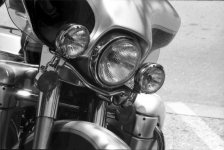I'll also defend the 135mm lenses. You're using a camera with a 1:1 viewfinder, which makes it surprisingly easy to see the field of view of a 135mm lens, compared with almost all other RF cameras (even the M3 reduces image size by nearly 10 percent).
The advantage of a 135mm lens is that, by using it, you CAN adequately use an RF camera instead of an SLR, because the 135 can do the work of a long telephoto ... crop and use half the frame with fine-grain film, and you've got the near equivalent of a 300mm f/3.5 in a very small, lightweight package. The 135mm lens is where long telephoto effects start to come into play, where you isolate the subject from the background. It's also where compression really starts to come into play, rendering distant scenes in a two-dimensional way reminiscent of classic paintings. It can also cover sports at the amateur level if you're allowed onto the sidelines of the field.
I wouldn't worry too much about frame-lines. Just shoot "loose." If you keep the RF patch over the subject, you'll catch it on film, and you can crop a bit to render pleasing compositions (and effectively lengthen the lens to 180 or 200mm). The best way to get a sense of composition with the 135 is to use one of your SLRs and either prime lenses or a zoom to compare the two focal lengths. Put the 135mm lens or zoom onto the SLR. Sit on a chair or couch where your head isn't going to move appreciably. Sight on a book case or some such thing using the SLR. Then put down the SLR and sight through the RF set to 90mm. Using the RF patch and 90mm frame lines, you should very quickly be able to get a sense of how much of the frame area the 135mm lens covers.
One other reason why I find it very easy to frame a 135mm lens when using a camera with a 1:1 viewfinder -- One of my photography books from the 1950s says that the human eye really sees a sharp field of view very close to that seen by the 135mm lens. If you just stare at something, without moving your eyes, there's only a small central part that's in focus and clear ... and that's very close to the field of view of a 135mm lens. When we look at an entire field of view in front of us, we're moving our eyes and sweeping them around to take it all in. The 1:1 viewfinder preserves this effect, so that I find it very natural to isolate images with the 135mm lens.




